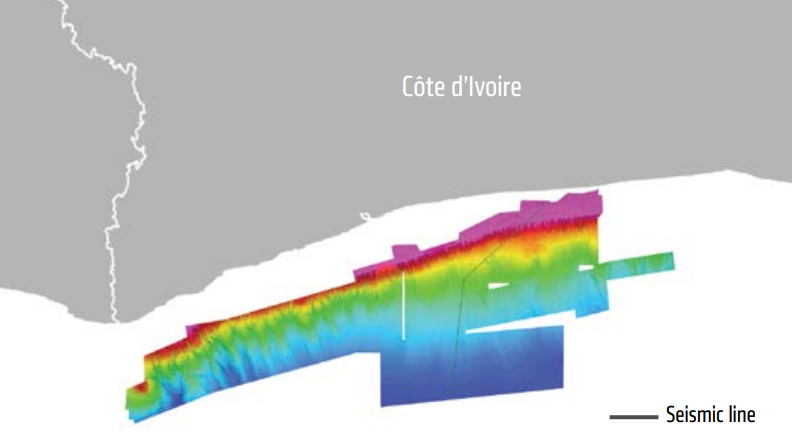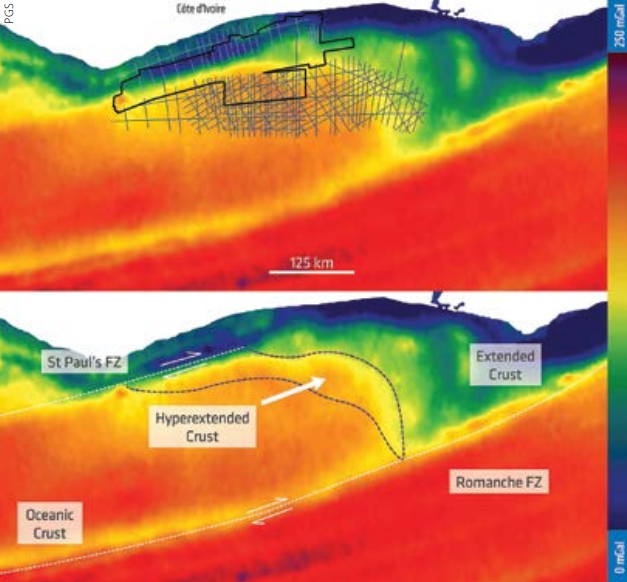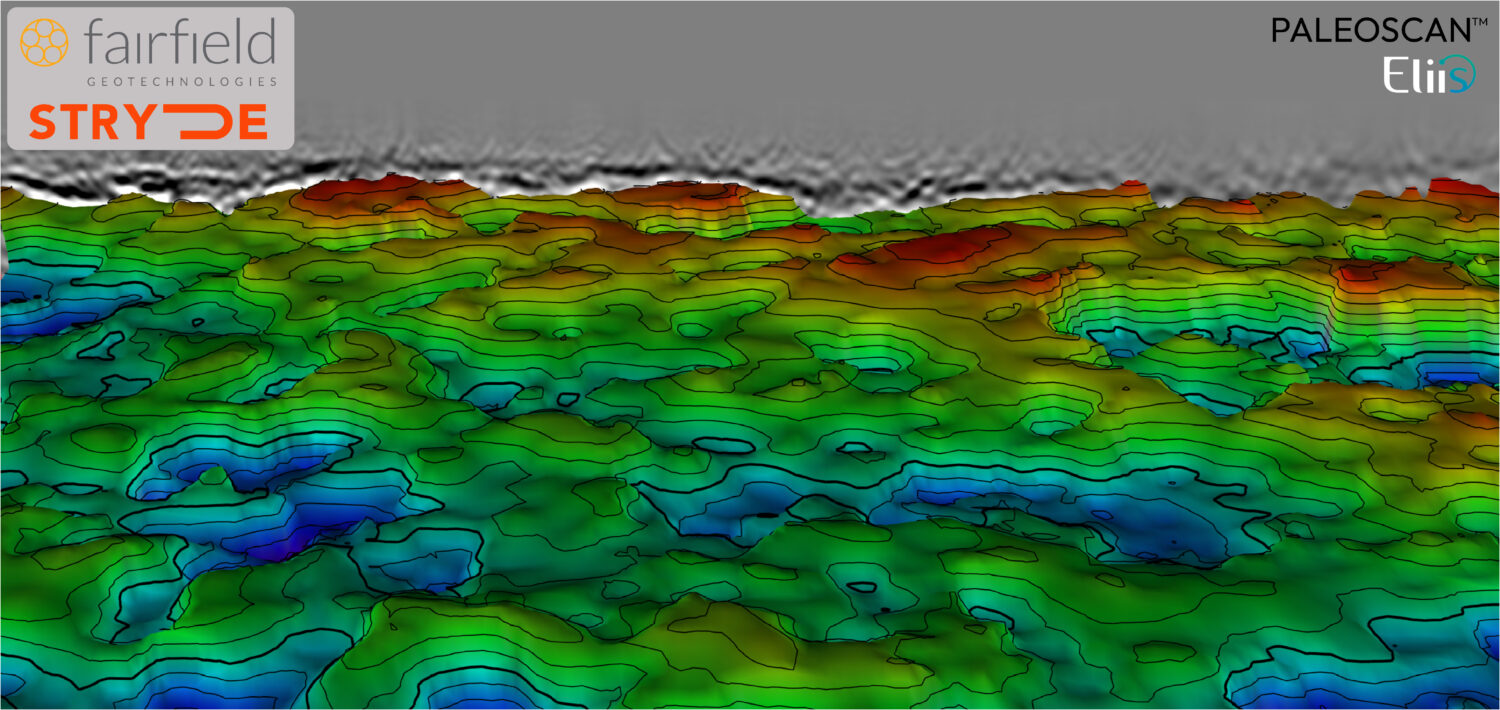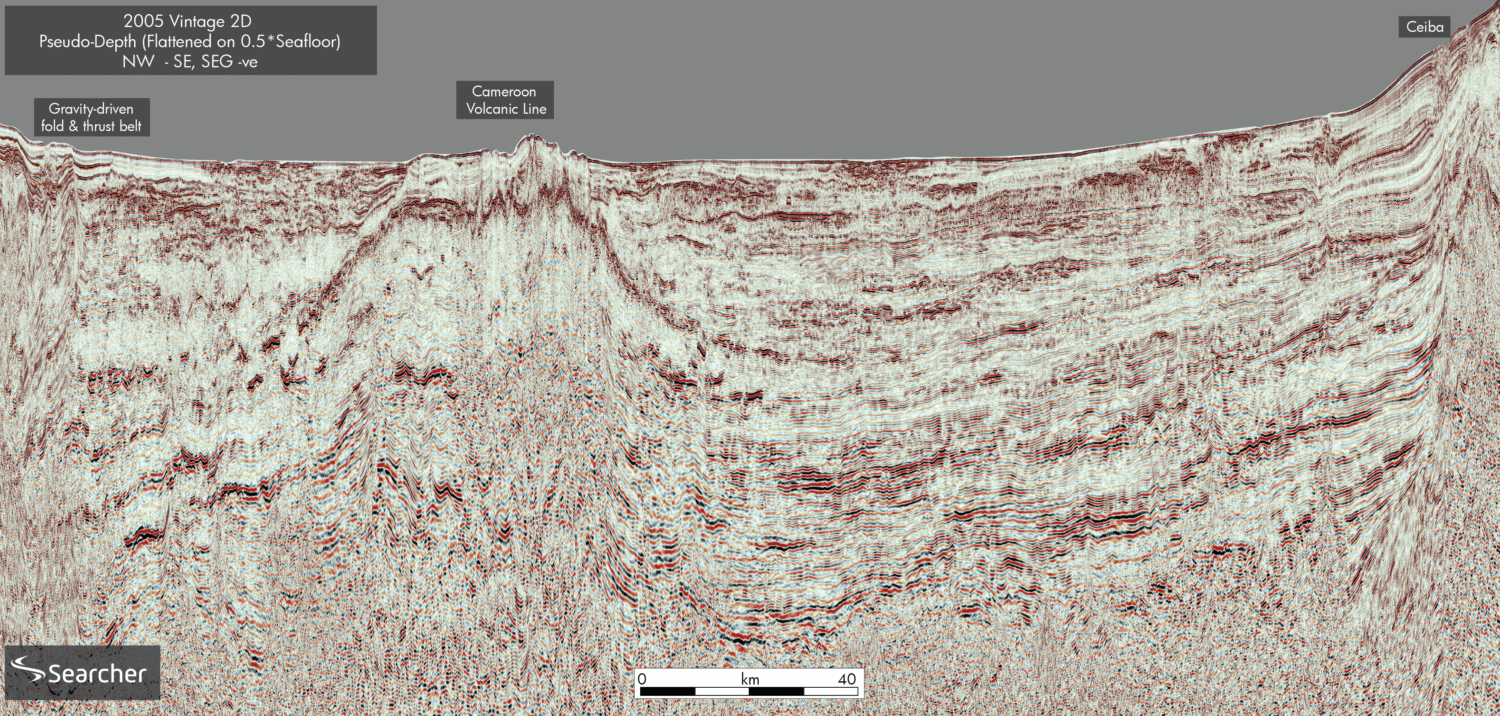
Extending Oil and Gas Exploration Potential to Western Côte d’Ivoire
Regional seismic data allows petroleum plays to be interpreted in full for the first time across the Côte d’Ivoire.
Exploration in Côte d’Ivoire has historically been focused on the central and eastern areas where numerous hydrocarbon discoveries have been made. These include a trend of gas discoveries in Upper Cretaceous stratigraphic traps (Foxtrot, Panthere and Marlin fields) and oil discoveries in Lower Cretaceous structural traps (Lion, Espoir, Acajou, Baobab and Kossipo fields). The Capitaine East-1X (Lukoil) and Paon (Anadarko) discoveries have proven the prospectivity of Upper Cretaceous oil-bearing stratigraphic plays in the deep water.
These exploration successes have encouraged explorers to look further afield in tectonically complex areas of the western transform area controlled by the St.Paul’s Fracture Zone. The Morue-1X well (Anadarko and Total) and Saphir-1X well (Total) have shown a working hydrocarbon system in the previously underexplored western portion of the basin.
Development of the Ivorian Transform Margin
Côte d’Ivoire is part of the West African transform margin, a large tectonically constrained area bounded by a series of major fracture zones which formed during the separation of the African and American continents in the late Jurassic to Cretaceous.

An overview of the tectonic framework using Bouguer corrected Smith and Sandwell gravity data (right) outlines the key structural features of the Côte d’Ivoire Basin. The development of the Ivorian embayment was controlled by a segment of the Atlantic rift delineated by the St. Paul’s fracture zone in the north and the Romanche fracture zone to the south. From east to west the crust transits from continental material with a low gravity response into increasingly dense oceanic crust. Along the northern margin this transition occurs more rapidly due to the area’s proximity to the transform fracture zone. Using the PGS Côte d’Ivoire MegaSurvey seismic data, hyperextended crust can be delineated in the transitional area, providing potential for new play concepts and increased understanding of basin development.
The western area of the Côte d’Ivoire Basin developed as a typically steep transform shelf margin characterised by transtensional faulting with local transpressional features likely to be controlled by pre-existing structure.
Using the merged seismic data, the development of the margin can be broken into three fundamental periods of tectonic activity:
1. Pre-transform – Untapped Deep Potential:
The pretransform stage has not been penetrated by drilling in the central Côte d’Ivoire Basin, although outcrops of rocks from Precambrian to Triassic age do exist in the Tano Basin to the east in Ghana. Pre-transform Jurassic rocks have also been found in the neighbouring Tano Basin. These consist of conglomerates and shales deposited in a continental setting.
The pre-transform stratigraphy has been deformed and tilted by subsequent transform faulting, creating excellent trapping geometries.
2. Syn-transform – Development of Petroleum System:
Elements: During the syn-transform stage (Berriasian to Albian), sediments were deposited in a continental and marginal marine setting in the Côte d’Ivoire Basin (Chierici, 1996), allowing for the accumulation of Middle Aptian source rocks. The environment became progressively marine during the Albian as rifting continued, leading to the deposition of sands, shales, calcareous deposits and conglomerates.
Inboard, the faulting associated with the transform superficially shows the appearance of typical rift normal faulting; however, secondary fault patterns and the tectonic setting indicate dextral oblique movements. Outboard there is clear evidence of hyperextended crust demonstrated by classic S-reflector (very low angle detachment faults) geometries.
This period corresponds to the syn-rift phase discussed in the literature covering the eastern passive margin setting of the Côte d’Ivoire Basin (Scarselli et. al., 2018).
3. Post-transform – Stratigraphic Trapping Potential:
The end of oblique transform movement was superseded by thermal subsidence in the post-transform stage (Cenomanian–Holocene). This phase almost entirely comprises clastic marine sandstones and shale deposition, with minor carbonate sediments. Potential reservoir rocks include ponded and channelised turbidite systems and basin floor channel and fan systems. The organic rich black shales deposited within topographic lows provide source rock potential.
Regional data allows broad assessment
The key to evaluating a relatively underexplored region (with respect to the rest of the offshore Côte d’Ivoire) such as the Ivorian Transform Margin is the availability of regional datasets. The PGS Côte d’Ivoire MegaSurvey offers a regional perspective of the tectonic activity and basin development, leading to a greater understanding of existing and potential petroleum systems. This covers both existing discoveries and open blocks available for licensing, so analogues can be drawn and a regional evaluation of existing successes and failures can be made.
In the following sections some key examples show the advantage that a regional dataset can have in understanding the geology and its implications for further exploration.
Hyperextended crust exploration opportunity
The foldout seismic section shows that the crust dramatically thins towards the offshore with evidence of hyperextension and S-reflectors across the base of the syn-kinematic packages providing potential for increased heat flux and source rock maturation. Distal areas are often dismissed as unprospective due to the limited maturation of source rocks through low levels of heat flux from radiogenic elements within remaining continental rocks (Doran and Manatschal, 2017). However, given recent advances in the understanding of margin development from seismic data and well results, it is becoming clear that this assumption is increasingly invalid (Doran and Manatschal, 2017). In magma-poor environments where the crust is able to extend significantly, the shallowing of the mantle controls increased heat flux. This can prolong the extension and drift phase of increased heat flux allowing for source rock maturation.
These distal areas of the Côte d’Ivoire could be productive with syn-kinematic stratigraphy being charged from a mature Aptian source. Another possible scenario is for a prevalent Cenomanian source rock to be matured allowing for the charge of the deepwater Cretaceous fan sandstones.
Results from the Kosmos exploration campaign across this terrain (deepwater part of the foldout) will provide valuable insight into the potential of these plays.

Regional mapping of Cretaceous Turbidite plays
The successful Cretaceous turbidite play is ubiquitous across the Côte d’Ivoire Basin. The regional nature of the PGS MegaSurvey 3D data provides an unprecedented ability to understand the distribution of the turbiditic sands. RMS amplitudes extracted through an interval of Cretaceous turbidite deposits clearly delineate the drilled channel systems to the east of the MegaSurvey and highlight that sediments were also sourced from the west. Basin-wide understanding provided by MegaSurvey seismic data allows for reliable regional depositional models to be built both spatially and temporally through geological time, allowing for the best potential targets to be identified for future exploration.
The Ivorian Transform Margin: A Promising Area for Hydrocarbon Exploration
The Ivorian Transform Margin is an exciting prospective area that now can be evaluated in detail in a regional context using the MegaSurvey. The initial results presented from this study show that plays in the well-established areas of the Côte d’Ivoire extend west, with new play potential also present. This opens the opportunity for operators to extend existing plays such as the Cretaceous turbiditic sandstones and to develop new plays in open acreage utilising new thinking of heat flux over hyperextended crust to exploit new potential source kitchens.
References
Chierici, M.A., 1996, Stratigraphy, palaeoenvironments and geological evolution of the Ivory Coast-Ghana basin, in Jardiné, S., de Klasz, I., and Debenay, J.-P., eds., Géologie de l’Afrique et de l’Atlantique Sud, 12 e Colloque de Micropalaéontologie Africaine, 2 e Colloque de Stratigraphie et Paléogéographie de l’Atlantique Sud, Angers, France, 1994, Recueil des Communications: Pau, Elf Aquitaine, Memoire 16, p. 293–303.
Doran, H. and Manatschal, G., 2017, Breaking Up is Never Easy. GEO ExPro, Vol 14, No. 9. (link)
Scarselli, N. Duval, G. Martin, J. McClay, K. Toothill, S., 2018, Insights into the Early Evolution of the Côte d’Ivoire Margin (West Africa). Geological Society of London Special Publication 476




